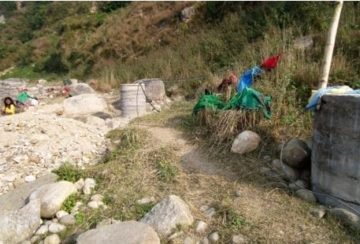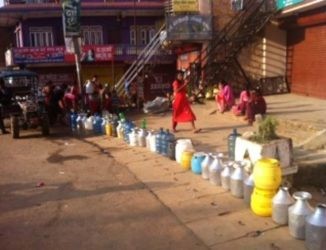Nepali town embraces diverse water supply strategies to spread risk, buffer shocks
Nepali town embraces diverse water supply strategies to spread risk, buffer shocks
The town of Bidur, Nepal demonstrates how small- and large-scale water schemes can complement each other and spread the risks of disruption to water supply. A diversified approach creates resilience to external shocks, whether it's earthquake or climate change. Kaustuv Raj Neupane, Kushal Pokharel, Dil Khatri and Kamal Devkota reflect on Bidur's experience.
Influenced by global water management practices, Nepal is moving towards a large-scale and centralised water system to address its burgeoning urban challenges and pressures.
Despite having certain limitations, like intermittent supply and small-scale coverage, the role of small water supply systems in effective water management is crucial, but remains ignored.
For instance, a recent ban on the use of local springs due to a hepatitis and jaundice outbreak in the Indian city of Simla, Himachal Pradesh, led to water shortages. This left the city’s 200,000 residents without water for weeks.
Increasing cases of the failure of large-scale, centralised water supply systems have been reported in the developed countries, such as United States. The ‘Flint water crisis’ in the United States, beginning in 2014 and owing to the city’s struggle to finance a water system, is a case in point.
In contrast to these centralised schemes, the town of Bidur has diversified its water management strategies i.e. maintaining small-scale locally managed sources alongside a large-scale municipal scheme. This blog narrates the story of Bidur focusing on the role of small-scale water schemes in ensuring water security in lower Himalayan towns.
Bidur: the context
Bidur, a small Nepali town, is located on the banks of the giant rivers Trishuli and Tadi and has an area of 34.55 sq.km. With a significant area covered by the valley and remaining area with the hills, the town depends on local springs and small community-managed schemes for domestic water use, a common practice in the growing lower Himalayan towns.
Although situated between the glacier-fed rivers of Trishuli and Tadi, Bidur has struggled hard to secure water for decades. The Bidur Water Users Supply Committee (BWUSC), which is a community institution of over 2,000 households in the town, covers nearly 40% of the Bidur residents; however, the actual supply of water is intermittent and limited.
In addition, three multiple small water users’ committees have been supplying water to the town. Recently, the large Asian Development Bank (ADB)-funded project is under construction with an aim to resolve the deepening water crisis by supplying 89 litres of water per second.
Yet, the diverse local sources and community-managed, small-scale schemes are crucial for ensuring water to residents of Bidur, particularly the population from poor and marginalised groups. However, the current focus on building the ADB-funded project raises questions of whether the existing multiple schemes will be maintained.
In light of the above, the water story of Bidur highlights how local community action has enhanced the coping capacities of people during disasters, promoting water access by the poor and marginalised community.
Multiple strategies for water security
More than 32 community-managed water users committees supply water to Bidur’s residents. Communities are engaged in managing water sources, distribution and maintenance of the system themselves. In addition, people have dug wells along the river banks and water is pumped to their houses for agriculture and poultry farming in addition to domestic use.
Residents of Bidur are relying on these diverse schemes. During a recent meeting, Shiva Ram Adhikari, President of Dolpe Drinking Water Users’ Committee, which supplies 20 taps to individual houses, said the water supplied from his system is good and will be operating even after the larger water project supplies come into operation. This shows that people feel ownership towards the small water users’ committees. In addition, people have a deep belief that the local spring water tastes good and they are attached to it. Rawal Dhara is an exemplary case but all settlements prefer to use spring water for drinking even though they have a piped water connection.
Earthquake shows how small water schemes lend resilience
Bidur was one of the hardest hit towns by the 2015 Gorkha earthquake and the major water supply collapsed for 15 days. During those days, people relied on water supplied by small water users’ committees.
A survey carried out by South Asia Institute of Advanced studies (SIAS) in 2016 reported that more than 55 percent of the households had to suffer from pipe destruction which was installed by the large water supply project. But more than 80 percent did not have to suffer severely as they had alternative water options, i.e. connection to small water scheme outlets in their yard or public water taps nearby.
When this story was shared in the Bidur Water Forum in September 2019, participants realised the importance of small water users’ committees. Deputy Mayor Gita Kumari Dahal remarked that he never realised their contribution, and added that the Municipality will not ignore the role of small users in the future:
“We are in need of devising a long-term strategy for water management. The research has shown how managing small and fragmented springs like ‘Batar’ and ‘Rawal’ taps can come to the rescue of the consumers when big projects incur certain problems. However, we have never thought this way but will contemplate this now”.
This was not the first time that Bidur’s water supply system collapsed as a result of earthquake. In the past, landslides damaged the in-take tank at the water source, as well as in a number of places in the distribution pipes, breaking the system.
The way forward
The story of Bidur’s water supply reveals how small water users have contributed to overcome major shocks and helped community resilience despite the low appreciation of their effort. It further demonstrates that small water users’ committees cannot totally cover the whole contribution of maintaining an adequate water supply. The key message to other town in the Himalayas is that they should understand the importance of small water supply systems in better water management. How multiple and diverse institutions can strengthen water supply system by improving their adaptive capacity has become evident.
The authors are researchers at South Asia Institute of Advanced Studies (SIAS).This article was first published on the SIAS website.
Images: Wells in river bank dug to supply water to the town (first, above); People queued in central town of Bidur for water on next day of Gorkha Earthquake of 25 August, 2015 (second, right and above right). Courtesy SIAS.


